Alcyone, also designated as Eta Tauri, is a multiple star system located in the zodiacal constellation of Taurus, the celestial bull. It is the brightest star in the Pleiades open cluster, surrounded by many fainter stars.
Key Facts & Summary
- Alcyone is the third brightest star in the constellation of Taurus after Aldebaran and Elnath, and the brightest star in the Pleiades cluster, the second being Atlas.
- The brightest star of the Pleiades cluster lies at an approximate distance of 440 light-years away from Earth.
- The Pleiades cluster, also known as Messier 45, is one of the closest open clusters to Earth.
- Alcyone has an apparent magnitude of 2.87 and an absolute magnitude of -2.62.
- The primary star in the Alcyone star system is Alcyone A. It is a giant blue-white star of spectral type B5IIIe.
- Alcyone A is part of a triple star system.
- Alcyone A has six times the mass of our Sun.
- When it comes to its radius, Alcyone has 9.3 solar radii, thus it is several times bigger than our Sun.
- Alcyone is 2,030 times brighter than our Sun. It produces a lot more energy.
- The surface average temperatures of Alcyone have been estimated to be at around 12,258 K.
- The rotational velocity of Alcyone is at around 149 km / 92.5 mi per second. This speed is quite great and most of the Pleiades stars share this feature.
- Alcyone has a surface gravity of 3.047 cgs.
- The zodiacal constellation of Taurus and the Pleiades open cluster were known to humanity for thousands of years.
- The Pleiades cluster is very bright, though, it cannot be seen during May and June since the Sun blocks our view of the cluster in that period.
Alcyone is named after one of the seven daughters of the titan Atlas and the sea-nymph Pleione, from Greek mythology. The seven sisters were nymphs and companions of the goddess Artemis.
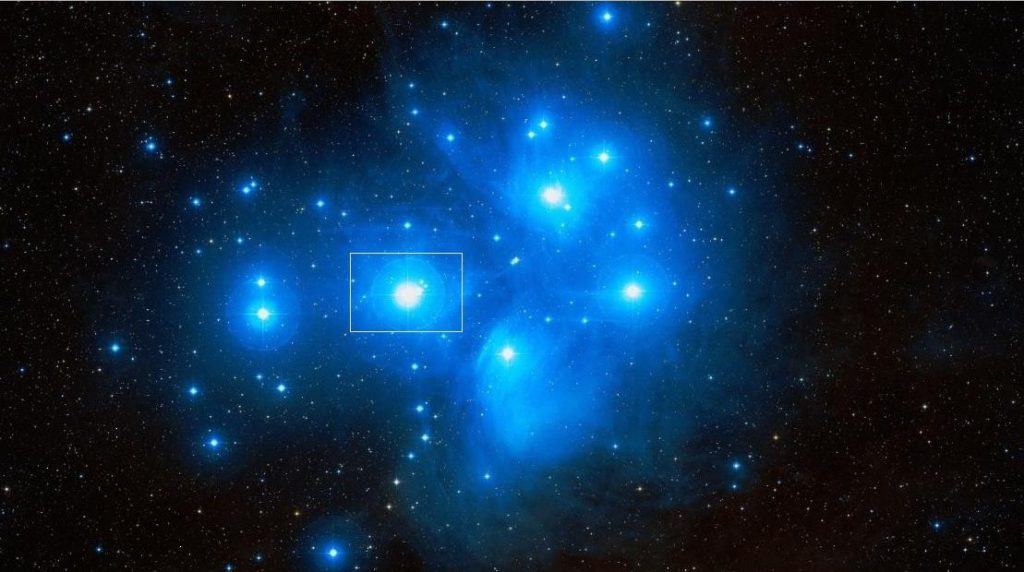
Alcyone would later have three children with the water god Poseidon, namely Hyrieus, Hyperenor, and Aethusa. The name Alcyone roughly translates to “kingfisher.” This name was approved in 2016 by the IAU.
Formation
Alcyone, along with its neighboring stars in the Pleiades cluster, formed between 75 and 150 million years ago. This open cluster is among the closest star clusters to Earth.
All the stars in the Pleiades cluster have a common origin, they formed through a gigantic molecular cloud of dust and gas. Gravity pulled the swirling gas and dust together and formed the Pleiades cluster.
The Pleiades cluster is overall dominated by very hot blue and luminous stars.
Distance, Size, and Mass
Alcyone is located at around 440 light-years / 136 parsecs away from the Sun. The blue-white star has around 6 solar masses, or 600% the sun’s mass.
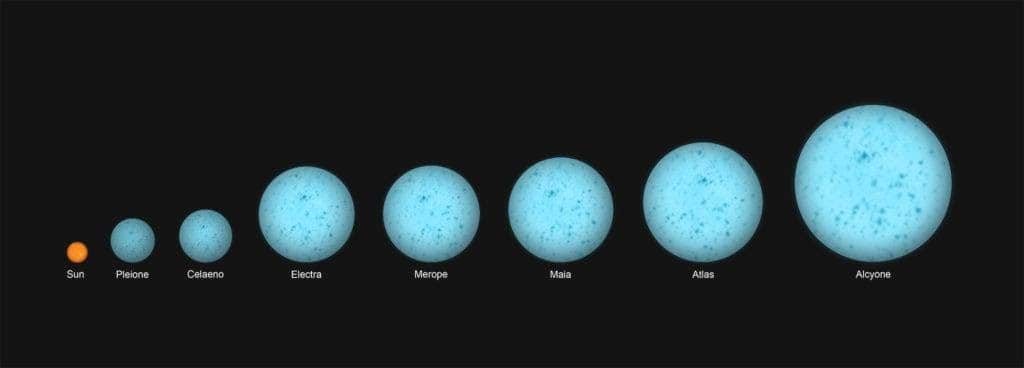
When it comes to its radius, Alcyone has 9.3 solar radii or 930% the Sun’s radius. Thus, Alcyone is more than 10 times the size of the Sun.
Other Characteristics
Alcyone is a blue-white star of spectral type B5IIIe, indicating that emission lines are present in its spectrum. Alcyone has surface average temperatures of 12,258 K or 2.2 times hotter than our Sun’s.
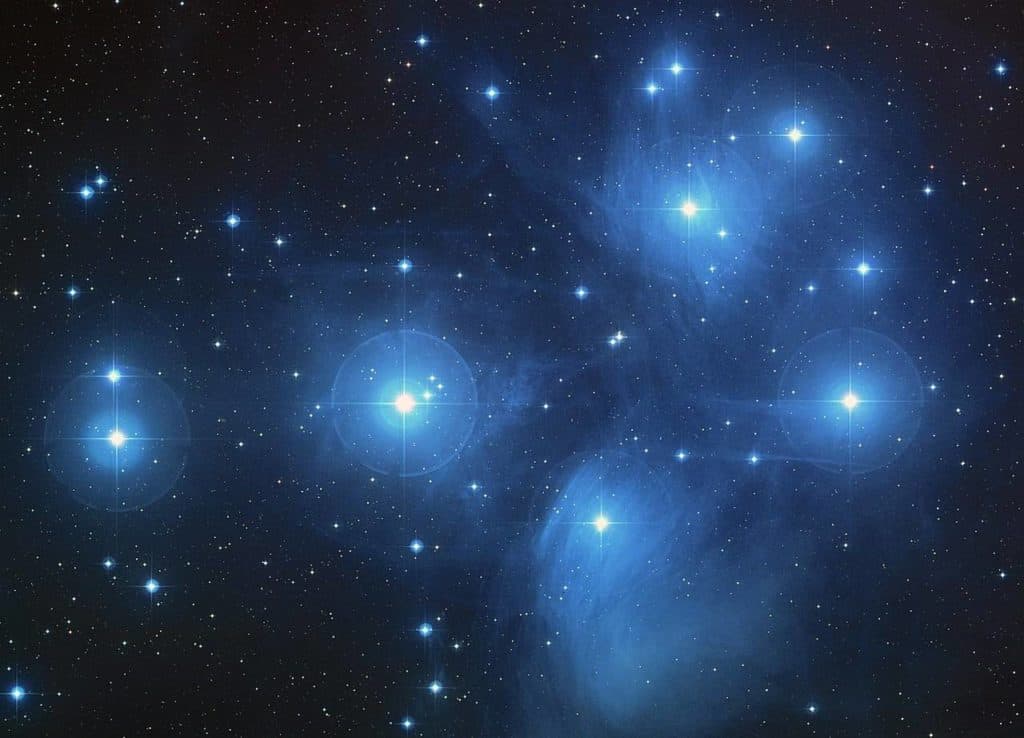
The giant blue star is also 2,030 times brighter than our Sun, though most of its output is in the invisible ultraviolet part of the spectrum. Alcyone is also cataloged as a Be star, since it spins very fast, with an estimated rotational velocity of 149 km / 92.5 mi per second.
Because of this great speed, Alcyone is surrounded by a disk of gas ejected around the equator.
Stellar System
Alcyone, also designated as Eta Tauri, is cataloged as a multiple star system in the Washington Double Star Catalog, and the Catalog of Components of Double and Multiple Stars.
The latter catalog lists Alcyone as the primary component and three other companions. Alcyone B is a white main-sequence star with an apparent magnitude of 6.28, located at a separation of 117” from Alcyone A.
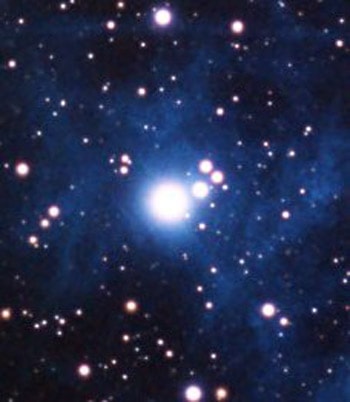
Alcyone C is a Delta Scuti variable star. Its brightness varies from magnitude 8.25 to 8.30 with a period of 1.13 hours. Alcyone D is a white main-sequence star with a visual magnitude of 9.15.
The Washington Double Star Catalog lists four more companions, all fainter than 11th magnitude, and it also describes Alcyone D as itself being a double star with two nearly equal components separated by 30”.
The closest companion to Alcyone A has a very low mass and is less than 1 milli-arcsecond away, with an orbital period of around 4 days. The third star has around half the mass of Alcyone A, and they are separated by 0.031 arcseconds – the same distance from the Sun to Jupiter. They have an orbital period of 830 days.
Location
Alcyone is located in the zodiacal constellation of Taurus, the celestial bull. It is the brightest star of the famous Pleiades open cluster. The Constellation of Taurus is also home to another great open cluster named Hyades.

This constellation is among the largest in the night sky, and also one of the most prominent of the northern constellations occupying an area of 797 square degrees.
The constellation of Taurus, apart from the two mentioned clusters, also has many interesting stars such as Aldebaran, Elnath, and also other fascinating deep-sky objects such as the Crab Nebula, Crystal Ball Nebula, merging galaxies and many more open clusters.
These celestial objects are best observed and studied during January.
Pleiades Member
Alcyone is the brightest star/member of the Pleiades open cluster. From October to April, these stars can be observed and studied, however, May and June are not suitable for observation since the cluster is too close to the Sun.
The Pleiades open cluster is among the closest star clusters to Earth, and one of the brightest in our vicinity. Though the cluster is very bright and easy to find, you may also draw an imaginary line from the stars of Orion’s Belt – Alnitak, Alnilam, and Mintaka – past Aldebaran – and find the cluster.
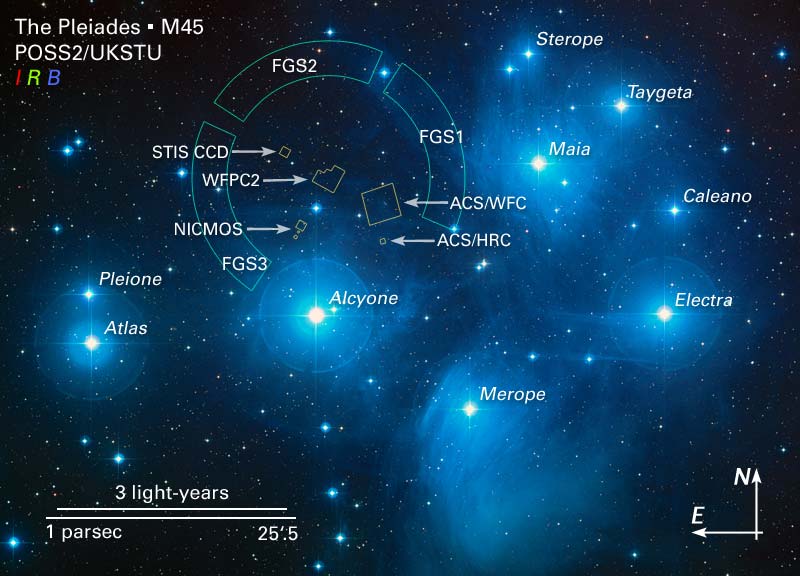
The Pleiades cluster is also known as Messier 45. The majority of the brightest and hottest stars here are of spectral class B, and they formed between 75 and 150 million years ago.
Most of them are far apart from each other, and at around 444 light-years away from us. The most documented and famous stars are all named after the mythological Seven Sisters and their parents from Greek mythology.
The nine stars are Alcyone, Asterope, Atlas, Electra, Celaeno, Maia, Merope, Taygeta, and Pleione. The mythological story depicts the sisters as they caught the eye of Orion, a giant huntsman. Atlas, being condemned for his battles against the gods, was condemned to carry the heavens on his shoulders while Orion, the giant, pursued his daughters.
However, the Greek god Zeus stepped in and transformed the sisters into doves, and then into stars to console their father. Even so, Orion, the giant, is still pursuing the Pleiades sisters across the sky, represented by the Orion constellation.
The Future
Alcyone will continue to exist for many millions of years however, the Pleides star cluster has been studied closely and many computer simulations predict a grim future.
Most simulations suggest that the cluster will continue to survive for 250 million years before it will start to disperse due to gravitational interactions with its galactic neighborhood.
Did you know?
- The Chinese know Alcyone as “Mao Xiu Iiu” – translating to The Sixth Star of Hairy Head – Hairy Head is a Chinese asterism consisting of the Pleiades stars Asterope, Atlas, Electra, Maia, Merope, Taygeta, and Alcyone. This asterism is one of the seven mansions of the White Tiger.
- The Pleiades star cluster is believed to have been formed from a compact configuration that resembled the Orion Nebula.
- Many cultures throughout the world knew of the Pleiades cluster since ancient times. One of the earliest depictions of the Pleiades cluster and its stars resides in the Nebra sky disk – a Bronze Age artifact dating to 1.6000 BCE, uncovered in Germany.
- Many famous and ancient texts mention the cluster, such as Homer’s Illiad and Odyssey, Hesiod’s Works and Days, the Bible, the ancient Egyptian Calendar of Lucky and Unlucky Days, and the Japanese Kojiki – An Account of Ancient Matters – the 8th-century chronicle of myths, oral traditions, and legends.
- The Pleiades are mentioned in the Kojiki as the Mutsuraboshi – translating to “six stars.” In modern Japan, the cluster is now known as Subaru – the same name used by the famous automobile company that depicts the six brightest stars in their logo.
- One of the first telescopic observations conducted on the Pleiades was during the 1610s. Galileo Galilei observed the bright stars and the cluster and it is noted that he may well be the first to have done so.
Sources:
Image sources:
- https://www.star-facts.com/wp-content/uploads/2019/11/Alcyone-1109×620.jpg?189db0&189db0
- https://www.universetoday.com/wp-content/uploads/2009/07/Messier-45.jpg
- https://www.daviddarling.info/images/Alcyone.jpg
- https://www.star-facts.com/wp-content/uploads/2019/10/Taurus-constellation.jpg
- https://upload.wikimedia.org/wikipedia/commons/e/e1/M45map.jpg
